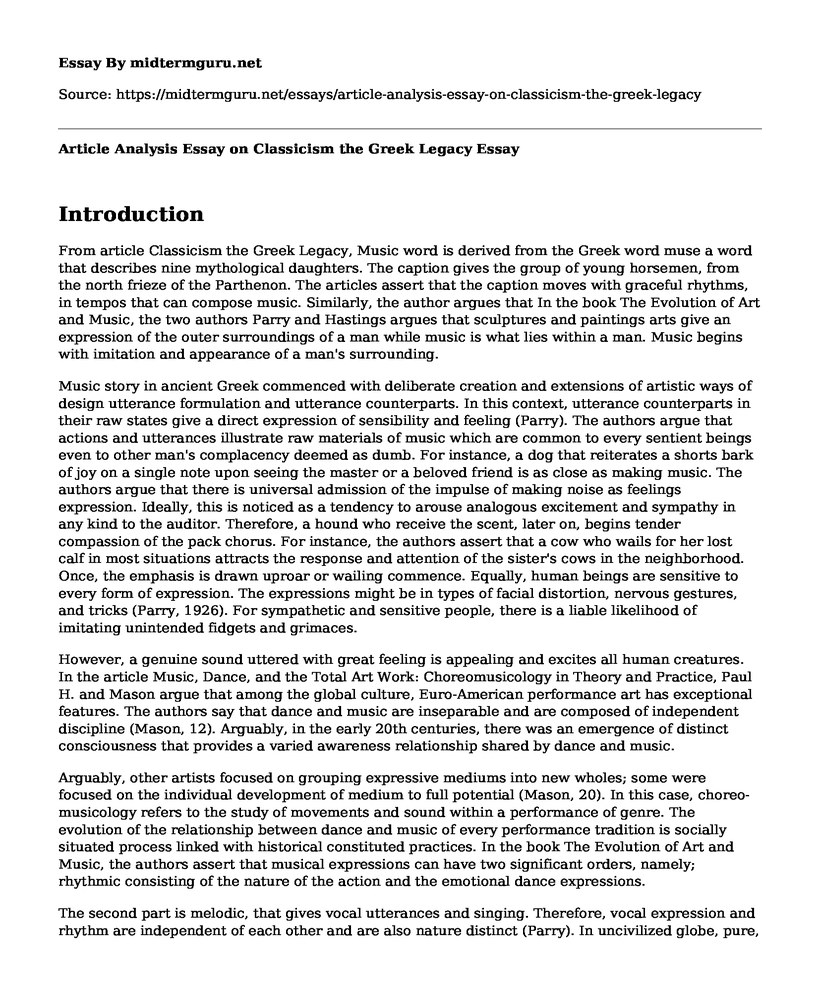Introduction
From article Classicism the Greek Legacy, Music word is derived from the Greek word muse a word that describes nine mythological daughters. The caption gives the group of young horsemen, from the north frieze of the Parthenon. The articles assert that the caption moves with graceful rhythms, in tempos that can compose music. Similarly, the author argues that In the book The Evolution of Art and Music, the two authors Parry and Hastings argues that sculptures and paintings arts give an expression of the outer surroundings of a man while music is what lies within a man. Music begins with imitation and appearance of a man's surrounding.
Music story in ancient Greek commenced with deliberate creation and extensions of artistic ways of design utterance formulation and utterance counterparts. In this context, utterance counterparts in their raw states give a direct expression of sensibility and feeling (Parry). The authors argue that actions and utterances illustrate raw materials of music which are common to every sentient beings even to other man's complacency deemed as dumb. For instance, a dog that reiterates a shorts bark of joy on a single note upon seeing the master or a beloved friend is as close as making music. The authors argue that there is universal admission of the impulse of making noise as feelings expression. Ideally, this is noticed as a tendency to arouse analogous excitement and sympathy in any kind to the auditor. Therefore, a hound who receive the scent, later on, begins tender compassion of the pack chorus. For instance, the authors assert that a cow who wails for her lost calf in most situations attracts the response and attention of the sister's cows in the neighborhood. Once, the emphasis is drawn uproar or wailing commence. Equally, human beings are sensitive to every form of expression. The expressions might be in types of facial distortion, nervous gestures, and tricks (Parry, 1926). For sympathetic and sensitive people, there is a liable likelihood of imitating unintended fidgets and grimaces.
However, a genuine sound uttered with great feeling is appealing and excites all human creatures. In the article Music, Dance, and the Total Art Work: Choreomusicology in Theory and Practice, Paul H. and Mason argue that among the global culture, Euro-American performance art has exceptional features. The authors say that dance and music are inseparable and are composed of independent discipline (Mason, 12). Arguably, in the early 20th centuries, there was an emergence of distinct consciousness that provides a varied awareness relationship shared by dance and music.
Arguably, other artists focused on grouping expressive mediums into new wholes; some were focused on the individual development of medium to full potential (Mason, 20). In this case, choreo-musicology refers to the study of movements and sound within a performance of genre. The evolution of the relationship between dance and music of every performance tradition is socially situated process linked with historical constituted practices. In the book The Evolution of Art and Music, the authors assert that musical expressions can have two significant orders, namely; rhythmic consisting of the nature of the action and the emotional dance expressions.
The second part is melodic, that gives vocal utterances and singing. Therefore, vocal expression and rhythm are independent of each other and are also nature distinct (Parry). In uncivilized globe, pure, and unalloyed music is commonly found. Therefore, the degree of excitement is what contributes to the rise, which is accompanied by drum beatings which lead to dancing (Parry). Dancing is ultimately derived from expressions of gestures through a rhythm that causes a balanced human body arrangement. Thus, it is difficult for frequent repletion of similar actions. Dancing express emotions and conveys excitement not only to the performer, but also the sympathetic listeners.
Works Cited
Mason, P. H. "Music, dance and the total artwork: choreomusicology in theory and practice." Research in Dance Education, vol. 13, no. 1, 2012, pp. 5-24, doi:10.1080/14647893.2011.651116.
Parry, C. H. The evolution of the art of music. 1926.
Cite this page
Article Analysis Essay on Classicism the Greek Legacy. (2023, Feb 11). Retrieved from https://midtermguru.com/essays/article-analysis-essay-on-classicism-the-greek-legacy
If you are the original author of this essay and no longer wish to have it published on the midtermguru.com website, please click below to request its removal:
- Rhetorical Analysis of a Reality TV Show - Paper Example
- The Effects of Digital Communication on Conversation Skills - Essay Sample
- Essay Sample on Liberty Challenges in Nineteenth-Century America
- Literary Analysis Essay on Girls at War
- Media Coverage of Terrorism: Terrorists as Celebrities? - Essay Sample
- Movie Analysis Essay on Memory of My Face
- Social Media: Benefits and Limitations of a Digital Revolution - Research Paper







